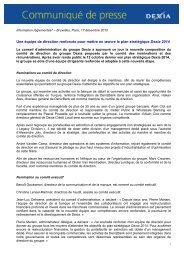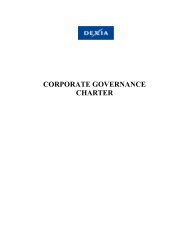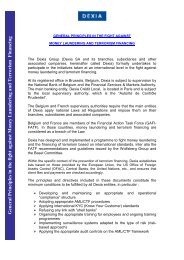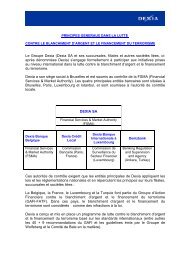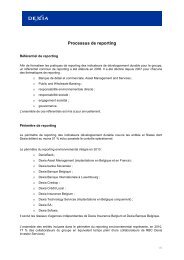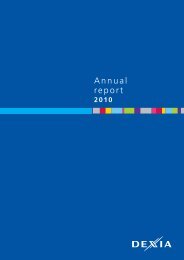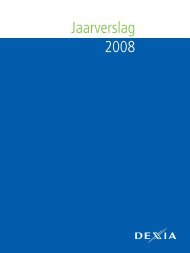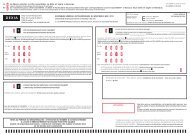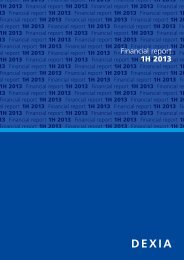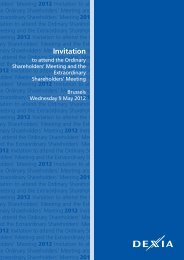Annual report 2009 - Dexia.com
Annual report 2009 - Dexia.com
Annual report 2009 - Dexia.com
- No tags were found...
You also want an ePaper? Increase the reach of your titles
YUMPU automatically turns print PDFs into web optimized ePapers that Google loves.
Notes to the consolidated fi nancial statements1.3.2. Jointly controlled entitiesA joint venture (JV) is a contractual arrangement wherebytwo or more parties undertake an economic activity thatis subject to joint control. Joint ventures are accounted forvia the proportionate consolidation method. In the financialstatements, joint ventures are integrated by <strong>com</strong>bination oftheir share of the assets, liabilities, in<strong>com</strong>e and expenses ona line-by-line basis.The same consolidation treatment, as for subsidiaries, isapplied for inter<strong>com</strong>pany transactions. When necessary, theaccounting policies of jointly controlled entities have beenamended to ensure consistency with the policies adopted by<strong>Dexia</strong>.1.3.3. AssociatesInvestments in associates are accounted for using the equitymethod of accounting. Associates are investments where<strong>Dexia</strong> has significant influence, but does not exercise control.This is usually the case, when <strong>Dexia</strong> owns between 20%and 50% of the voting rights. The ownership share of netin<strong>com</strong>e for the year is recognised as in<strong>com</strong>e from associatesand the investment is recorded in the balance sheet at anamount that reflects its share of the net assets including netgoodwill.Unrealised gains on transactions between <strong>Dexia</strong> and its“equity method investments” are eliminated to the extent of<strong>Dexia</strong>’s interest. Unrealised losses are also eliminated unlessthe transaction shows evidence of an impairment of theasset transferred. The recognition of losses from associatesis discontinued when the carrying amount of the investmentreaches zero, unless <strong>Dexia</strong> has incurred or guaranteed obligationsin respect of the associates’ undertakings. Where necessary,the accounting policies of the associates have beenamended to ensure consistency with the policies adopted by<strong>Dexia</strong>.1.4. Offsetting financial assets and financialliabilitiesFinancial assets and financial liabilities are offset (and consequently,the net amount is only <strong>report</strong>ed) when <strong>Dexia</strong> has alegally enforceable right to offset and intends either to settleon a net basis, or to realise the asset and settle the liabilitysimultaneously.1.5. Foreign currency translation andtransactionsThe consolidated financial statements are stated in EUR, thecurrency in which <strong>Dexia</strong> is incorporated.1.5.1. Foreign currency translationOn consolidation, the statements of in<strong>com</strong>e and cash flowstatements of foreign entities that have a functional currencydifferent from <strong>Dexia</strong>’s presentation currency are translatedinto <strong>Dexia</strong>’s presentation currency (EUR) at average exchangerates for the year or the period and their assets and liabilitiesare translated at respective year-end or quarter-end exchangerates.Exchange differences arising from the translation of the netinvestment in foreign subsidiaries and associates and of borrowingsand other currency instruments designated as hedgesof such investments, are recorded as a cumulative translationadjustment within shareholders’equity. On disposal of a foreignentity, such exchange differences are recognised in thestatement of in<strong>com</strong>e as part of the gain or loss on sale.Goodwill and fair value adjustments arising from the acquisitionof a foreign entity are treated as assets and liabilities ofthe foreign entity and are translated at the closing rate.1.5.2. Foreign currency transactionsFor individual <strong>Dexia</strong> entities, foreign currency transactions areaccounted for using the approximate exchange rate at thedate of the transaction. Outstanding balances denominatedin foreign currencies at period or year-end are translated atperiod or year-end exchange rates for monetary items andnon-monetary items carried at fair value. Historical rates areused for non-monetary items carried at cost. The resultingexchange differences from monetary items are recorded inthe consolidated statement of in<strong>com</strong>e; for non-monetaryitems carried at fair value, the exchange differences follow thesame accounting treatment as for fair value adjustments.1.6. Trade date and settlement dateaccountingAll “regular way” purchases and sales of financial instrumentsare recognised and derecognised on the settlementdate, which is the date of delivery to or by <strong>Dexia</strong>. However,financial instruments held for trading are recognised andderecognised at trade date.For financial assets and liabilities measured at initial recognitionat fair value, <strong>Dexia</strong> recognises from the trade date anyunrealised gains or losses arising from revaluing the contractto fair value at the <strong>report</strong>ing date. These unrealised gains andlosses are recognised in the statement of in<strong>com</strong>e unless thetransactions have been assigned to cash flow hedge relationshipsor are related to an available-for-sale asset.1.7. Realised gains and losses on salesof financial assetsFor financial assets not revalued through the statement ofin<strong>com</strong>e, realised gains or losses on disposals is the differencebetween the proceeds received (net of transaction costs)and the cost or amortised cost of the investment (net ofimpairment).1.8. Impairments on financial assets<strong>Dexia</strong> records allowances for impairment losses when there isobjective evidence that a financial asset or group of financialassets is impaired, in accordance with IAS 39 § 58-70. Theimpairments represent the management’s best estimates oflosses at each balance-sheet date.An interest-bearing financial asset is impaired if its carryingamount is greater than its estimated recoverable amount.The amount of the impairment loss for assets carried atamortised cost is calculated as the difference between theasset’s carrying amount and the present value of expectedfuture cash flows discounted at the financial instrument’soriginal effective interest rate or current effective interest rateManagement <strong>report</strong>Consolidatedfinancial statements<strong>Annual</strong> financial statementsAdditional information<strong>Annual</strong> <strong>report</strong> <strong>2009</strong> <strong>Dexia</strong> 109



